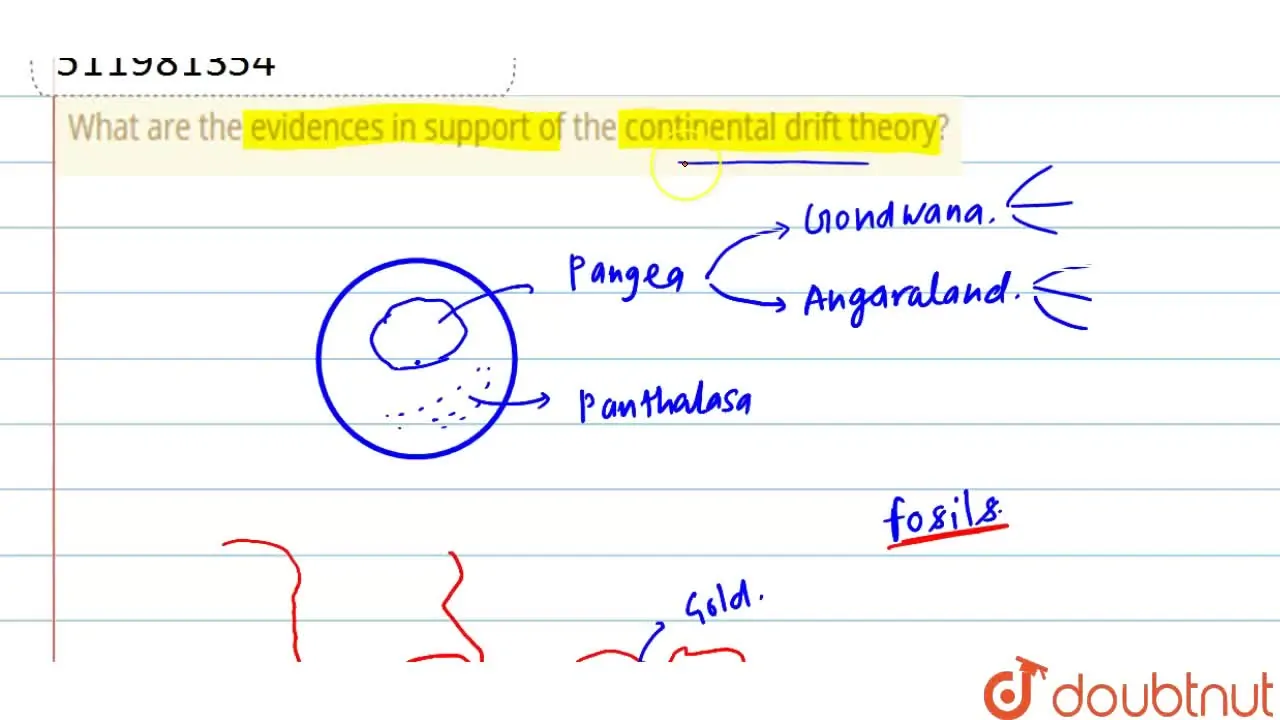What are the evidences in support of the continental drift theory?
A variety of evidence was offered in support of the continental drift. Some of these are given below:
(a) The Matching of Continents (Jig- Saw-Fit): The shorelines of Africa and South America facing each other have a remarkable and unmistakable match.
(b) Rocks of Same Age Across the Oceans: The belt of ancient rocks of 2,000 million years from Brazil coast matches with those from western Africa. The earliest marine deposits along the coastline of South America and Africa are of the Jurassic age. This suggests that the ocean did not exist prior to that time.
(c) Tillite: It is the sedimentary rock formed out of deposits of glaciers. The Gondawana system of sediments from India is known to have its counter parts in six different landmasses of the Southern Hemisphere. At the base the system has thick tillite indicating extensive and prolonged glaciation. Counter parts of this succession are found in Africa, Falkland Island, Madagascar, Antarctica and Australia besides India. Overall resemblance of the Gondawana type sediments clearly demonstrates that these landmasses had remarkably similar histories. The glacial tillite provides unambiguous evidence of palaeoclimates and also of drifting of continents.
(d) Placer Deposits: The occurrence of rich placer deposits of gold in the Ghana coast and the absolute absence of source rock in the region is an amazing fact. The gold bearing veins are in Brazil and it is obvious that the gold deposits of the Ghana are derived from the Brazil plateau when the two continents lay side by side.
(e) Distribution of Fossils: The observations that Lemurs occur in India, Madagascar and Africa led some to consider ..Lemuria.. linking these three landmasses. Mesosaurus was a small contiguous landmass reptile adapted to shallow brackish water. The skeletons of these are found only in two localities : the Southern Cape province of South Africa and Iraver formations of Brazil. The two localities presently are 4,800 km apart with an ocean in between them.
Related Playlists
- BOOK - FULL MARKSCHAPTER - DISTRIBUTION OF OCEANS AND CONTINENTSEXERCISE - ADDITIONAL QUESTIONS WITH ANSWERS (I. Multiple Choice Questions)12videos
DISTRIBUTION OF OCEANS AND CONTINENTS
- BOOK - FULL MARKSCHAPTER - DISTRIBUTION OF OCEANS AND CONTINENTSEXERCISE - ADDITIONAL QUESTIONS WITH ANSWERS (II. Very Short Answer Type Questions)21videos
DISTRIBUTION OF OCEANS AND CONTINENTS
- BOOK - FULL MARKSCHAPTER - COMPOSITION AND STRUCTURE OF ATMOSPHERE EXERCISE - TEST ASSIGNMENT (III. Answer the following questions in 160 words. )1videos
COMPOSITION AND STRUCTURE OF ATMOSPHERE
- BOOK - FULL MARKSCHAPTER - DRAINAGE SYSTEM EXERCISE - ADDITIONAL QUESTIONS WITH ANSWERS (VI. HOTS QUESTIONS )4videos
DRAINAGE SYSTEM
Similar Questions
Evidences In Support Of Continental Drift
View SolutionContinential drift explains
View SolutionContinential drift explains
View SolutionName two evidences in support of Lamarckism.
View SolutionWho was the profounder of continental drift theory?
View SolutionWho is the exponent of Continental Drift theory?
View SolutionIntroduction|Continental Drift|Evidence in Support of The Continental Drift|Rocks of Same Age Across The Oceans|Tillite|Placer Deposits|Force for Drifting|One Minute Revision
View SolutionIntroduction|Continental Drift|Evidence in Support of The Continental Drift|Rocks of Same Age Across The Oceans|Tillite|Placer Deposits|Force for Drifting|One Minute Revision
View SolutionWhat is the evidence in support of the fact that (a) sound is a wave (b) sound is a mechanical wave (c) sound waves are longitudinal.
View SolutionExplain the basic concept of continental drift theory.
View Solution


